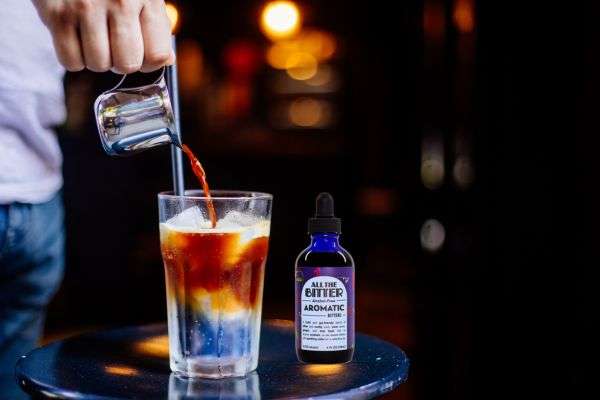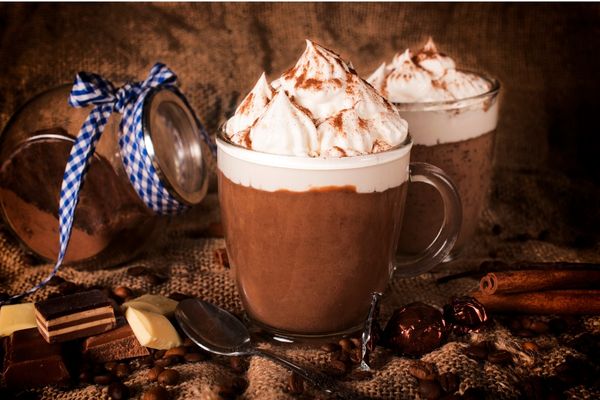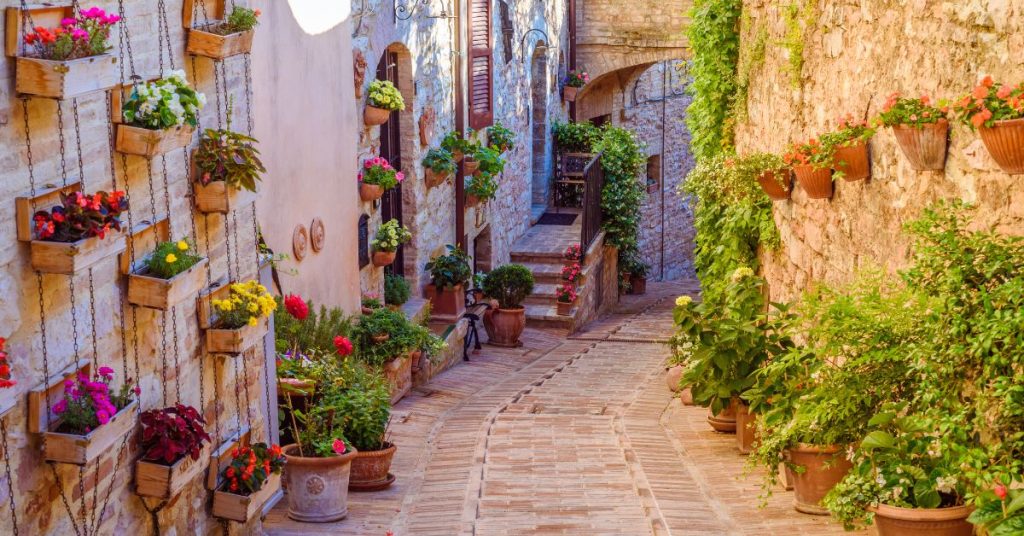Of course, Italy is renowned for its wide variety of wines and liqueurs. But aren’t you curious about the non-alcoholic Italian drinks that the country has to offer?
When you think of Italy, aperitivo, boozy drinks, and images of rooftop terraces or noisy bars packed with locals swiftly come to mind. Nevertheless, the nation that gave the world cocktails like Spritz and Negroni also creates fantastic non-alcoholic selections.
Let’s dive into the top 22 non-alcoholic Italian drinks.
Espresso
Espresso is the name of a coffee beverage and the Italian way of boiling coffee.
Today, it is made worldwide using the espresso machine, which Angelo Moriondo created in Turin in 1884.
It works by applying a small amount of hot water at high pressure to ground coffee beans finely. You can also use an Italian Press.
The coffee used for espresso is a blend of different roasts, and pressurized brewing results in a beverage with intense flavors and a thick, almost syrupy texture.
Because espresso contains more caffeine than other types of coffee, it is typically served as a shot.
Lavazza is the coffee of choice in Comedians In Cars Getting Coffee.
Espresso Tonic
An espresso tonic with 2-4 (start with 2) full droppers of All The Bitter – Aromatic is just what you need to get you through your afternoon meetings. Add ice cubes to your glass, 4 ounces tonic water, 2 ounces of espresso, 2 full droppers All The Bitter Aromatic bitters. Stir. You won’t even believe how good it is. Everyone in the break room will want one. By adding the espresso last you’ll get a gorgeous layered look.

Espresso Tonic
Ingredients
- 4 ounces tonic water
- 2 ounces espresso
- 4 full droppers All The Bitter Aromatic bitters
Instructions
- Add ice cubes to your glass.
- Add All The Bitter Aromatic bitters and tonic water.
- Add espresso last to get that gorgeous layered look.
Notes

Espressino
Espressino is made with heated milk, chocolate powder, and an espresso shot.
Typically, the beverage is served in a tiny shot glass. The drink is put together by first pouring cocoa powder into the glass, followed by espresso.
The beverage is finished with a coating of steaming milk and occasionally with a last sprinkling of cocoa powder. Instead of using cocoa powder, other varieties employ chocolate spreads.
Capuccino
Italian coffee, called a cappuccino, is made with espresso and steam-foamed milk. It is thought to have evolved from kapuziner, a coffee-based brew popular in 18th-century coffee establishments in Austria.
The term “cappuccino” was initially used in Italy in the 1930s, albeit at the time the beverage was topped with whipped cream before taking on its modern appearance with the development of the espresso machine.
A single or double shot of espresso is pulled, and steamed milk is added on top. The traditional cappuccino in Italy is always served in small cups that are occasionally pre-heated. In Italy, it is advised to have more foam than liquid.
Due to its popularity outside of Italy, cappuccino can change greatly from its native country’s form and can be consumed at any time of day, whereas Italians hardly ever drink them in the afternoon. The Capuchin friars are thought to have inspired the name cappuccino because the hues of coffee and milk are similar to those of their robes.
Watch this video from Munchies on YouTube if you want to learn how to make the best Capuccino at home.
Macchiato
Espresso is used to make the original Italian macchiato, then topped with just one or two teaspoons of heated milk. The milk should always stay within the coffee because it is simply introduced to enhance the flavor.
The word literally means “marked” or “stained,” and it refers to the tiny amount of milk that is used just to color espresso.
Caffè macchiato was developed as an alternative to ordinary espresso and is primarily used as an afternoon beverage in Italy, unlike cappuccino, which is typically drunk in the morning.
The beverage shouldn’t be mistaken for the latte macchiato, which uses the opposite proportions of coffee and milk.
Marocchino
Marocchino, also referred to as vetrino, has its roots in Piedmont. It consists of a shot of espresso with cocoa powder dusted on top and frothed milk on top. The milk is then typically sprinkled with chocolate powder.
The Carpano Tavern in Alessandria is thought to be where marocchino first appeared. It was created in the early half of the 20th century and was based on the bicerin, an espresso drink with hot chocolate on top and whipped cream on top.
It’s commonly believed that the term marrocchino, which translates to “Moroccan,” was chosen because of the coffee’s brownish hue, which resembled an eponymous brand of exquisite leather that was well-liked in the 1930s.
Caffè Latte
The origin of the espresso-based coffee known as caffè latte (or caffè e latte) is still being determined. It consists of an espresso with steamed and occasionally lightly frothed milk on top. The typical ratio, which frequently varies, is 1:3 in favor of milk.
Caffè latte was first used in 1867 when William Dean Howells used the phrase in his book Italian Travels. To make the beverage more appealing to foreigners, it is frequently asserted that it is descended from cappuccino, but it actually belongs to a vast class of European-style coffees that also contain milk, like the French caffè au lait and the Spanish café con leche.
While having European roots, the modern caffè latte’s global success is frequently attributed to the United States, where it rose to popularity in the 1980s.
Caffè Moka
The typical moka pot, an electric or stovetop aluminum pot created by Alfonso Bialetti in 1933, is used to make caffè moka, an Italian-style coffee. Like an espresso maker, it heats the water before pressuring the steam through the ground coffee.
The resulting coffee has a stronger flavor profile than traditionally brewed coffee. The moka pot was created to provide an accessible and convenient alternative to traditional Italian espresso. It is primarily used for home brewing, and it was named for the Yemeni city of Mocha, which was historically a significant port for the trade of coffee.
Shakerato
Iced coffee’s Italian equivalent is called shakerato.
It’s made with ice cubes and sweetened espresso that are shaken together in a cocktail shaker, hence the name.
The beverage is typically drunk in the summer as a cool alternative to conventional espresso.
Due to its special preparation, the beverage should have a bubbly coating (crema) on top when it is poured into a glass. Typically, it is strained and served in a glass with a stem. Shakerato is frequently spiked with liqueurs that have creamy vanilla or coffee flavors.
Bicerin
Bicerin is a traditional Turin beverage, which dates to the 18th century, is made of espresso, hot chocolate, and whipped cream. Tall, clear glasses are usually used for preparation and serving; all three layers should be visible.
Despite being popular throughout Turin, bicerin is said to have originated in Caffè Al Bicerin and Caffè Florio. It is thought that its name comes from the diminutive of bicchiere called bicchierino (glass).
Add a bit of pizzaz with Lyre’s non-alcoholic coffee liquor.
Barbajada

This Milanese beverage, known as barbajada or barbagliata, is made from freshly brewed espresso or café forte that has been diluted with milk and mildly sweetened.
After that, cocoa or chocolate flavoring is added, and whipped cream is then drizzled over the entire dish. Domenico Barbaja, a waiter at Caffè dei Virtuosi, a café next to La Scala opera house, created this frothy dessert beverage in 1859.
The cocktail quickly gained popularity among Milan’s elite, and Barbaja went on to become not only a prosperous businessman but also one of the most significant Italian opera impresario of the 19th century and a casino tycoon. This foamy drink goes perfectly with Milanese sweets like the exquisite panettone, which is loaded with candied fruit.
Barbajada is typically served hot in the winter, but it can also be poured over ice and savored chilled in the summer.
Caffè d’Orzo
Caffeine-free orzo, sometimes known as caffe d’orzo or just orzo, is an Italian hot beverage that was first produced as a less expensive substitute for coffee, which was then both expensive and difficult to get.
The Italians have created a beverage similar to coffee in flavor and appearance by perfecting the difficult-to-roast barley due to its delicate nature.
Orzo is a light-tasting dish with hints of whisky and dark chocolate made with ground, roasted barley. It can be prepared with an espresso machine or an orziera, a special moka pot modified for barley.
Caffè di Anterivo
Caffè di Anterivo is a caffeine-free alternative to coffee derived from the legume seeds of Lupinus pilosus, a flowering plant also known as blue lupine that grows abundantly in the sand-filled areas of Altrei (Anterivo), South Tyrol. Lupinus belongs to the same family of legumes as peas and peanuts.
Although the seeds have a variety of uses, in Altrei, they were primarily used to make this beverage that is similar to coffee. The plant’s legumes (seeds) are roasted before being processed into a powder that can be brewed similarly to normal coffee. The beverage has a coffee-like flavor, however, it lacks the typical astringency of coffee and instead has a mild nutty and cocoa flavor.
Usually, it is served hot. Anterivo coffee was a particularly well-liked local good until the 1960s. Since then, the custom has disappeared as normal coffee has become more widely available and less expensive. It has only recently been advertised as a traditional South Tyrolian product.
Ristretto
Ristretto, which translates as “limited” in Italian, is one-half of an espresso shot. In addition to the quantity of water used in its production, it differs from an ordinary espresso in taste since it is less bitter.
When made in an espresso maker, the usual quantity of finely ground coffee is extracted using only half the water required for traditional espresso. The end product is a stronger beverage with a different ingredient balance than regular espresso.
While the crema in ristretto is significantly lighter than in standard espresso, it looks like dark chocolate. In a demitasse cup, ristretto is traditionally served undiluted.
Brasilena
Calabria is the birthplace of the non-alcoholic coffee soda known as Brasilena. Natural coffee flavors and spring water from a nearby source are used to make the beverage.
It is a refreshing carbonated beverage with a distinctive dark brown hue, mild carbonation, and strong coffee flavor.
The first batch of this soda, which has been sold for more than 50 years, was made in 1982, and it quickly garnered a devoted following throughout southern Italy, particularly in Calabria, Apulia, Sicily, and Campania. Also, it is exported to several other nations. Local Calabrian business Acqua Calabria makes the beverage.
Brasiliena is frequently consumed as a cool, revitalizing beverage and added to drinks. It still has a retro appearance reminiscent of the 1960s, with a predominance of brown and yellow colors, and it is packaged in glass bottles and aluminum cans.
Non-Alcoholic Aperol Spritz
Aperol Spritz is a typical Italian drink that is traditionally bitter and bubbly, with just enough sweet and sour ingredients for balance, and is best served over ice in a balloon glass.
A non-alcoholic Aperol spritz recipe is super simple. We take the Aperol spritz 3-2-1 approach.
- 3 ounces Prima Pavé Dolce (trust us on this)
- 2 ounces Ritual Aperitif Alternative
- 1 ounce soda water (we love any orange flavored soda water)
Crodino
After going through a number of coffee variations as non-alcoholic Italian drinks, we’ll divert to the most well-known non-alcoholic Italian drink, the aperitif in Italy, Crodino.
It was developed in 1965 and later purchased by Gruppo Campari in 1995.
It hails from Crodo, a town in Piedmont, and is still bottled there today despite having a radioactive orange tint.
Crodino is spiced with six-month-old cardamom, nutmeg, and clove maceration. On the taste, orange and grapefruit predominate with quinine herbal rooty bitterness, vanilla, and moderate citric acidity. The aroma is zesty and citrusy.
The Campari company advocates combining finger foods like tapas, cheese, and cold cuts and serving them in a wine goblet with lots of ice and an orange slice.
Check out this review of Crodino by Sober Cellar on YouTube!
Chinotto
Several Italian sodas have a specific flavor profile that includes chinotto, a sort of mildly bitter and acidic citrus from the myrtle-leaf orange tree.
One of the crowd favorites chinotto soda is Lurisia, an Italian company that has long gotten its mineral water from Fonte Santa Barbara di Lurisia in the Western Alps.
The main component is the Savona chinotto, developed in China and now grown in the Italian Riviera and protected by Slow Food.
It is common to notice the peculiar carbonation and bittersweet balance of the hazy, amber-colored soda.
To prepare Chinotto Today, extracts of the zingy sun-ripened oranges are combined with orange blossom blooms, cinnamon, rhubarb, and an often-proprietary blend of herbs.
The flavor is, in a word, bitter, but it’s also aromatic and goes great with anchovies, fried fish, or puntarelle (a bitter Italian vegetable).
Spuma
The Italian equivalent of cola is called spuma, and it’s produced with sparkling water, sugar, caramel, and other flavorings.
In the early 20s, it was only available in “blonde” or as a drink designed to be served over ice with lemon and flavors of rhubarb, oranges, and vanilla.
The first “black” version was developed by the Spumador firm in 1938, amplifying the bitterness with the inclusion of herbs and an infusion of chinotto (the myrtle-leaf orange that is ubiquitous in Italian aperitivi).
These days, spuma comes in a wide range of other tastes, including mint and elderflower.
Frequently, sugar syrup and lemon juice are added to create a mocktail that is well-liked all summer long.
Gazzosa
Italian lemonade, or gazzosa, is sweet and fizzy. It used to be created traditionally by letting water, sugar, and lemon ferment in the sun to create a straightforward beverage that was frequently used to dilute wine or beer.
The best gazzosa is currently created with sweet and sour Sfusato lemons from the Amalfi coast and spring water from Lurisia in the Italian Alps. It has a strong citrus flavor and goes well with seafood dishes. It may also be converted into a wonderful sorbet. At certain bars, the glass is infused with mint or licorice before being drunk.
Ginger-Flavored Drinks
One of the more difficult-to-locate aperitivos on this list is Gingerino.
With television commercials proclaiming that “Eating is not a problem if there is an appetite. And appetite is prepared thanks to Recoaro Gingerino! The famous, delicious alcohol-free aperitif,” it gained notoriety in the 1970s.
This vibrant orange soda was named from the English term for ginger and is a native of Triveneto, which comprises the three Italian regions of Venezia Euganea, Venezia Giulia, and Venezia Tridentina.
In reality, it has a distinct flavor that is comparable to ginger beer but with more citrus overtones. It is bitter and slightly effervescent.
You can still purchase a bottle in the northeast at taverns and eateries.
Another example of an Italian ginger-flavored drink is Baladin Ginger.
This drink isn’t a ginger beer or ginger ale, nor does it truly contain ginger, according to Italian artisan brewer Teo Musso.
It replaces the typical soda water in the house Americano, made with Martini Bitter, Mancino Vermouth Rosso, and a pinch of salt. It is likely named for its striking color.
Together with bitter orange peel, lemon juice, and brown sugar, it is seasoned with a special combination of spices and botanicals. The amount of carbonation and the aroma can be enjoyed, just like an orange soda (but for adults!).

Now, you’re gonna want to visit Italy not just for its delightful wines and liqueurs. Even though this list contains a lot of caffeine options, who doesn’t love coffee, right? If you want to stick with Italian cocktails, non-alcoholic ones also exist. Check out these non-alcoholic negroni recipes.
If you’re in the mood for exploring non-alcoholic drinks from different nations, you might want to take a peek at these:
Non-Alcoholic Italian Drinks FAQs
What is the most popular non-alcoholic drink in Italy?
The most well-known Italian aperitif without alcohol is called crodino. The bright orange beverage has a bittersweet, citrusy flavor with hints of orange and grapefruit and is created with sugar and herbal extracts.
What non-alcoholic drink goes with Italian food?
One of the most popular Italian food is pizza. Pizza’s characteristically creamy, cheesy flavor can be complemented by beverages like lemonade, sparkling water, or almost any soda. You can try Gazzosa. An Italian lemonade, or gazzosa, is sweet and fizzy.
What Italian mocktails can I make?
There’s a wide range of Italian mocktails that are popular at sober parties nowadays. One is the Italian Strawberry Basil mocktail. It is made with balsamic strawberries, fresh basil leaves, crushed ice, and soda water or tonic water.
What mocktail goes well with pasta?
Sparkling water might be the best non-alcoholic Italian drink that is paired with pasta.
Pour your bubbles into a cold glass, whether you prefer LaCroix or San Pellegrino, and enjoy. Any pasta dish pairs well with sparkling water’s mildly bitter flavor, which will transport you to an Italian restaurant.
